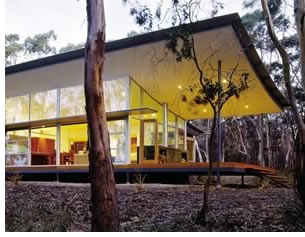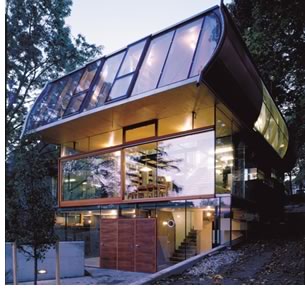

4/2006
AIA provides sponsorship to foster sustainability in residential design

The National Building Museum in Washington, D.C., hopes to convince the American public that green is not only a socially conscious choice, but a relatively affordable one as well. The museum for the first time is exploring the growing mandate for residential green design through “The Green House: New Directions in Sustainable Architecture and Design.” The milestone exhibition will remain on view for a year—May 20, 2006–June 3, 2007—and feature a full-sized house plus exhibits of 21 green houses from around the globe.
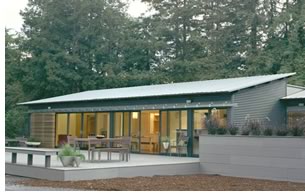 Visitors to The Green House will encounter a full-size recreation of
the California-based architect Michelle Kaufmann’s Glidehouse™,
a single-story, prefab Modern house graced with glass curtain walls and
louvered-wood sliding panels, which, incidentally, comes in at $120 per
square foot. Visitors can walk through its great room and kitchen space,
laid out to maximize breezes and minimize the need for artificial lighting.
They can examine firsthand the built-in cabinets, bamboo flooring, carpet
tiles of recycled materials, countertops made from recycled paper, and
furniture of organic textiles and sustainably harvested/reclaimed wood.
Cut-away walls and windows allow glimpses of the roof and wall structure.
Water-saving fixtures and a tankless water heater outfit the bathroom.
Walls are finished in low-VOC paint.
Visitors to The Green House will encounter a full-size recreation of
the California-based architect Michelle Kaufmann’s Glidehouse™,
a single-story, prefab Modern house graced with glass curtain walls and
louvered-wood sliding panels, which, incidentally, comes in at $120 per
square foot. Visitors can walk through its great room and kitchen space,
laid out to maximize breezes and minimize the need for artificial lighting.
They can examine firsthand the built-in cabinets, bamboo flooring, carpet
tiles of recycled materials, countertops made from recycled paper, and
furniture of organic textiles and sustainably harvested/reclaimed wood.
Cut-away walls and windows allow glimpses of the roof and wall structure.
Water-saving fixtures and a tankless water heater outfit the bathroom.
Walls are finished in low-VOC paint.
High tech and high touch
The architecture firm that designed and installed this 7,000-square-foot
exhibition is Lewis.Surumaki.Lewis, New York City. Organizer for The
Green House is Curator Donald Albrecht, the exhibition director and
catalog editor of “The Work of Charles and Ray Eames: A Legacy
of Invention,” a traveling exhibition organized by the Library
of Congress and the Vitra Design Museum, Weil am Rhein, Germany (1997-2005).
A noted designer of architecture-themed exhibitions, he also writes
widely on design and architecture. “This show illustrates that
environmental priorities and the highest aesthetic standards are fully
complementary,” says Albrecht. “Today we are seeing architects
and interior designers combining new, high-tech materials and old-fashioned
architectural wisdom to create houses that are glamorous, comfortable,
and sit lightly on the land.”
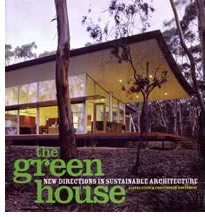 The exhibition catalog, The Green House:
New Directions in Sustainable Architecture—coauthored
by the exhibition’s consulting curators,
Alanna Stang and Christopher Hawthorne, and copublished by the National
Building Museum and Princeton Architectural Press—features more
than 35 residences in 15 countries, with designers ranging from starchitects
to little-known practitioners. Visitors to the exhibition will receive
a free resource newsletter that includes a glossary of green terms; directories
of leading architects, interior designers, builders, advocacy groups,
and others; and listings of ways to get additional information on green
building and design.
The exhibition catalog, The Green House:
New Directions in Sustainable Architecture—coauthored
by the exhibition’s consulting curators,
Alanna Stang and Christopher Hawthorne, and copublished by the National
Building Museum and Princeton Architectural Press—features more
than 35 residences in 15 countries, with designers ranging from starchitects
to little-known practitioners. Visitors to the exhibition will receive
a free resource newsletter that includes a glossary of green terms; directories
of leading architects, interior designers, builders, advocacy groups,
and others; and listings of ways to get additional information on green
building and design.
An array of varied houses
The Green House exhibit highlights 21 homes considered by the curators
to be especially interesting and beautiful. The curators displayed
the projects according to the environment to which they respond.
Desert
- Tucson Mountain House, Tucson, by Rick Joy Architects (2001)
- Loloma 5 Lofts, Scottsdale, Ariz., by Will Bruder Architects (2004)
Waterside
- Howard House, West Pennant, Nova Scotia, by Brian MacKay-Lyons Architects (1999)
- Swart Residence, Melbourne, Australia, by Cocks Carmichael (2004)
- Walla Womba Guest House, Tasmania, by 1+2 Architecture (2003)
- House with Shades, Jebenhausen, Germany, by Achenbach Architekten + Designer (2000)
- R128, Stuttgart, Germany, by Werner Sobek Ingenieure (2002)
- Great (Bamboo) Wall, Commune by the Great Wall, Shuiguan-Badaling, China, by Kengo Kuma & Associates (2002)
Tropics
- Taylor House, Scotland Cay, Bahamas, by Frank Harmon and Associates (2001)
- Casa de Carmen, Baja California Sur, Mexico, by Leddy Maytum Stacy Architects (2001)
- Casuarina Beach House, Kingscliff, New South Wales, Australia, Lahz Nimmo Architects (2001)
- Mill Valley Straw-Bale House, 2001; Marin County, Calif., by Arkin Tilt Architects
- Solar Tube House, Vienna, Austria, by Driendl Architects (2001)
- Charlotte Residence, Charlotte, N.C., by William McDonough + Partners
City
- Sea Train House, Los Angeles, by Office of Mobile Design (2003)
- Colorado Court Apartments, Santa Monica, Calif., by Pugh + Scarpa Architecture (2002)
- P.A.R.A.S.I.T.E. Project, Rotterdam, the Netherlands, by Stuhlmacher and Korteknie Architecten (2001)
- VIIKKI, Ongoing; Helsinki, Finland, by various architects (ongoing)
- The Solaire, The Verdesian, and Site 3; New York City, by Pelli Clarke Pelli Architects (2002, 2006, and completion 2007, respectively)
- Historic Front Street, New York City, by Cooke and Fox (2005).
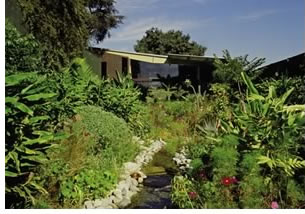 There’s more!
There’s more!
In addition to the houses, one section of the exhibition is devoted to
explaining five green principles:
- Wisely using the land
- Working with the sun
- Creating high-performance and energy-efficient houses
- Improving indoor air quality
- Wisely using the earth’s material resources.
Visitors can play with a heliodon and view displays that illustrate the broader topics of sustainable design, including building near mass transit and selecting materials with minimal toxic properties. The exhibition also features the Materials Resource Room containing samples and information about 60 different green materials, from coconut palm flooring to 3-D recycled wallpaper.
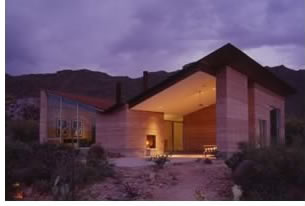 The museum will present concurrent lectures, construction watch tours,
films, and a major scholarly symposium this fall on the design and construction
of green houses. Interactive, kid-friendly components also will feature
displays, for instance the family-oriented “Was Kermit Wrong: Is
It Easy to Be Green?” is on the slate for May 21. In fact, all
of the museum’s school programs for this year and its annual Festival
of the Building Arts will focus on sustainable principles. After its
stint at the Building Museum, The Green House tours nationwide to venues
that include Los Angeles, Chicago, and New York City.
The museum will present concurrent lectures, construction watch tours,
films, and a major scholarly symposium this fall on the design and construction
of green houses. Interactive, kid-friendly components also will feature
displays, for instance the family-oriented “Was Kermit Wrong: Is
It Easy to Be Green?” is on the slate for May 21. In fact, all
of the museum’s school programs for this year and its annual Festival
of the Building Arts will focus on sustainable principles. After its
stint at the Building Museum, The Green House tours nationwide to venues
that include Los Angeles, Chicago, and New York City.
Copyright 2006 The American Institute of Architects.
All rights reserved. Home Page ![]()
![]()
The AIA is a major supporter of The Green House: New Directions in Sustainable Architecture and Design.
Joining the AIA as contributors are: ASID Foundation of the American Society of Interior Designers; Bosch home appliances; Portland Cement Association; Benjamin Moore® Paints; EPA/Energy Star, U.S. Department of Energy; Hardwood Manufacturers Association; National Association of Home Builders; Smith & Fong Plyboo®; Kohn Pedersen Fox Associates PC; National Association of Realtors®, Pelli Clarke Pelli Architects, and other contributors.
For more information about the exhibition, visit the National Building Museum online.
![]()
